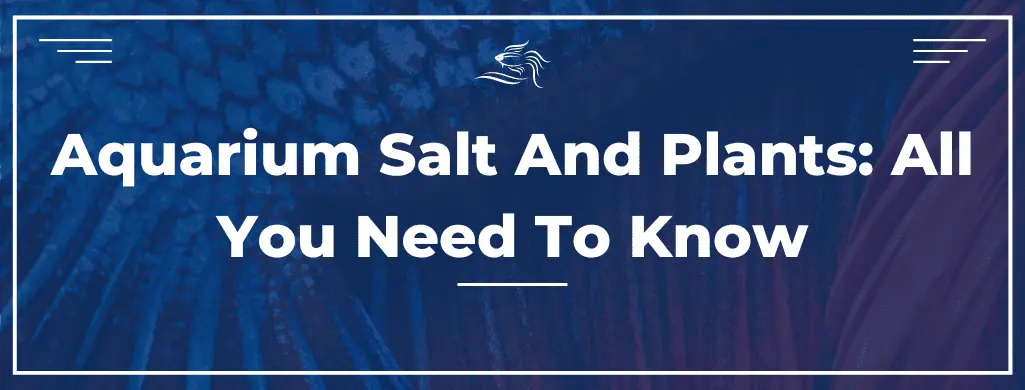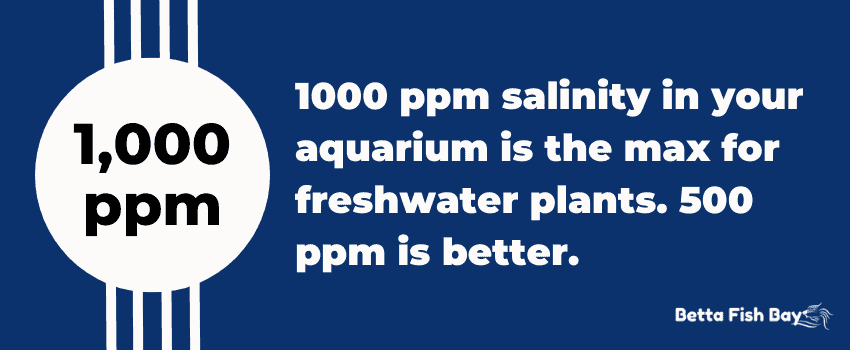Aquarium salt is a great tool for freshwater fish keepers. It’s usually used to treat illnesses like parasites and infections.
But in a planted tank, there are a lot of risks associated with using aquarium salt.
Many freshwater plants are not used to salt, so there is a danger of harming them.
Most freshwater plants can survive small amounts of aquarium salt. High concentrations of salt kill some plant species through dehydration. Other aquatic plants might live for several weeks with salt in the tank. Aquarium salt stunts plant growth but take a long time to actually kill anything.

Table of Contents
Can Aquarium Salt Harm Your Plants?
In short, aquarium salt is harmful to many freshwater plant species.
Extreme salinity causes a lot of stress in aquarium plants used to a freshwater tank.
Using aquarium salt on sensitive plants often leads to dehydration and wilting.
But it also impacts the growth rate of new plants. This is because your plants focus more on survival than development and growth.
Of course, sometimes, they meet high concentrations of salt. Then your plants put more energy into maintaining their osmotic gradient.
Osmosis is when a substance makes its way through a semi-permeable membrane. In this case, the membrane belongs to your plants.
An osmotic gradient is a balance between two substances on either side of the membrane.
In other words, your plants fight to keep their water content up. This is hard when there’s a dehydrating substance at play.
If you add more salt, the plants start to push water outward.
They want to maintain the balance we’ve just talked about. But this is impossible with so much sodium chloride.
When they can’t do this, the result is dehydration and the death of plant cells.
Sometimes these effects are reversible through good plant care.
But you need to be careful not to let the salinity level get too high or permanent damage is done.
Preventing Harm with Aquarium Salt

If your freshwater aquarium dweller has a disease, use a quarantine tank.
This protects both the fish and your freshwater aquarium plants from further harm.
Some think aquarium salt is a panacea for mystery diseases. But it is not such a miracle cure for your plants.
Another option is to use a different kind of treatment for your fish, something you know is plant-safe.
There are lots of targeted treatments you put right in the aquarium water. They are easy to use and effective.
For example, here’s a treatment called Melafix. This is highly popular and treats bacterial infections in betta fish.
This doesn’t cause the same water loss in your plants and is a safer option in a planted tank.
These treatments are often better at eliminating external parasites and bacteria anyway.
Certain illnesses, though, like nitrite poisoning, are best treated with aquarium salt. Don’t be afraid to use it, just keep in mind the effect it may have on your plants.
Which Plant Species Tolerate Aquarium Salt?
Generally, your plants want as little salt as possible in their environment.
But the truth is, some plants tolerate higher concentrations without issue.
Here’s a list of some of the hardier plants for your aquarium:
- Ambulia (limnophila sessiliflora)
- Anubias (anubias barteri)
- Dwarf hygro (hygrophila polysperma)
- Dwarf sagittaria (sagittaria subulata)
- Java fern (microsorum pteropus)
- Java moss (vesicularia dubyana)
- Sago pondweed (stuckenia pectinata)
- Wendt’s cryptocoryne (cryptocoryne wendtii)
These plants range from ferns to moss to grass.
It’s easy enough to get both carpet plants and bushy ones without losing them to low salt levels.
They tolerate slightly different levels of salinity. Some of these plants are native to brackish waters.
But all these plants easily survive the salt needed to prevent nitrite poisoning.
With any other common aquarium plant species, do lots of research before using salt.
Remember, salt usually hinders freshwater plant growth. Unless you know a plant is not salt sensitive, err on the side of caution.
Optimal Salinity: Measure and Adjust Doses of Salt

Dosing Salt to Avoid Osmotic Stress
Most common salt treatment regimes don’t take more salt than your plants can tolerate.
Freshwater is any water with less than 1000 ppm salinity. Some sources give even lower salinity levels, down to 500 ppm.
Most freshwater plant species do alright with doses of salt as high as a quarter-tablespoon of salt per gallon of water.
This means in a five-gallon tank, it’s safe to use just about four teaspoons of salt.
You would use about one tablespoon of salt for three gallons of water for mild issues.
This is slightly more than most plants tolerate well.
But if the treatment works as planned, remove the salt through partial water changes. Within a week or so, the salinity should be back to normal.
Your plants won’t suffer any permanent damage from such a small exposure period.
If the smallest dose does not work, use more aquarium salt to treat your fish. First, move them to a quarantine tank.
Otherwise, use disease-specific medications and keep up water changes to remove excess salt.
Remember, using a lot of salt is hard on your fish and plants. You must be careful not to give your betta burns or stress them out.
Measuring Salinity in the Aquarium
Many water testing kits include some sort of a salinity measuring tool.
But there are also digital salinity testers for those who use them more often. Here’s a digital tester available on Amazon, which measures up to about 10,000 ppm.
Test the water for salinity and other chemical levels when your betta or plants look sickly.
Don’t Be Salty with Your Plants
In truth, it’s best to remove your sick fish from the planted tank when treating them with aquarium salt.
But many freshwater plants tolerate low doses of salt without problems.
Maybe you use aquarium salt more regularly or keep a brackish tank. Then plants like anubias and java moss are your best friends.
You might also want to read our article on how to be safe with aquarium salt.


